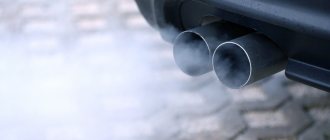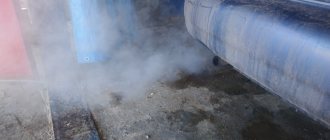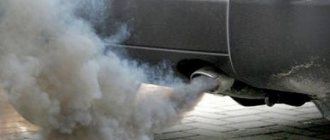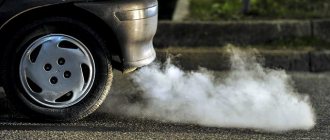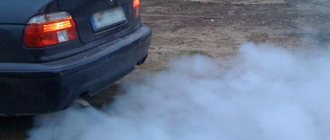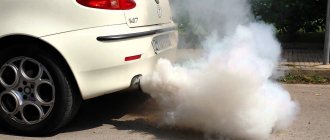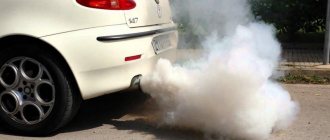What does the blue smoke coming from your car's exhaust pipe mean? Doesn't he remind you of Bluebeard from Charles Perrault's fairy tale? This villain killed his wives allegedly because of their excessive curiosity, which he considered a moral flaw. Well, what can we say, he is a maniac and a maniac in France. Moreover, some believe that curiosity is not a vice, but a source of knowledge.
Curious readers will learn from this article what leads to such a beautiful color of a car exhaust.
Why does a gasoline engine smoke?
When you see a smoking car on the road, you can confidently say that there are problems with its engine. If it is in good condition, the exhaust will be transparent, since it does not contain any coloring substances. What do gasoline engine exhaust gases consist of?
95% of their volume consists of nitrogen, oxygen, as well as gaseous products of gasoline combustion: nitrogen oxides, carbon oxides and hydrocarbon radicals. All these substances are colorless, so the human eye cannot detect them. Finally, from 3 to 5% of the exhaust is water vapor, which is a product of pyrolysis (thermal decomposition) of gasoline molecules.
It remains to be assumed that smoke from the muffler pipe appears when some foreign substances other than gasoline are burned in the engine cylinders. And indeed it is. A gasoline engine uses some auxiliary materials during operation. Liquid motor oil is used to lubricate parts, and coolant (antifreeze or antifreeze) is used to cool the cylinders.
For a number of reasons, these liquids can enter the cylinders, where they mix with fuel. The products of their combustion give color to the exhaust gases - the engine begins to smoke. Moreover, the escaping smoke can have different colors and shades. They can be divided into three groups: white, blue and black smoke. An experienced mechanic can determine the cause of the malfunction by the nature of the smoke.
Checking the functionality of the injectors
If one of them is clogged, the motor will “triple”: it’s not difficult to figure out the culprit. You need to start the engine and turn off each injector one by one. A change in the sound of a running motor indicates the normal condition of the part. If there is no response from the power unit, we can assume that the problematic spare part has been found. But if the nozzle overflows, then finding it will require a more complex procedure. Before testing, prepare a 20 ml disposable syringe and a transparent dropper tube.
Further:
- remove the plunger from the syringe;
- start the engine and connect the syringe to the “return” of the nozzle, i.e. insert the tube into the neck of the medical instrument;
- hold the syringe for a couple of minutes until it fills with diesel fuel (if it does);
- repeat the operation for all injectors.
An empty syringe or 4-5 ml of diesel fuel in it indicates the serviceability of the part. The presence of 10-15 ml inside is a sign of its partial functionality (repair and cleaning are possible). A volume of 20 ml of fuel in the syringe indicates the need to replace the injector. The exact volume of diesel fuel that it must dump back must be indicated in the vehicle instructions.
Schematic representation of injectors
This is interesting: How to check the vacuum brake booster 2109
What does blue smoke mean?
To understand why the engine emits blue smoke, just use a simple indicator. A sheet of writing paper is brought to the muffler pipe. After some time, the paper surface becomes covered with oil drops.
This indicates that oil particles give the blue or blue color to the exhaust. But, if it is present in the exhaust gases, it means that it somehow enters the combustion chamber. If the reader mentally imagines its structure, it is not difficult to identify probable sources. They may be:
- Intake manifold channels. During the suction stroke, the intake valves open, through which, theoretically, oil can enter along with air (or the fuel-air mixture in carburetor engines).
- Crankcase. Oil leaks from the crankcase space when there are any malfunctions of the piston rings.
- Valve box. Oil penetrates through worn intake or exhaust valve seals (oil seals).
Problems with the turbocharger (turbine)
Its malfunctions can be identified independently, without removing the unit from the machine. In addition to the appearance of black (gray) smoke from the exhaust pipe, problems with the turbocharger are indicated by:
- excessively noisy engine operation under load;
- constant overheating;
- reduction of power unit traction and dynamics;
- increase in fuel consumption.
You can check the performance of the turbine by ear and visually. A normally functioning unit should not creak, hiss or whistle. Check the tightness of the pipe connections and the condition of the air filter. To make sure that there is no wear on the device, turn its rotor: it should not touch the body (play of no more than 0.05 mm is allowed).
There are also unexpected reasons when the engine smoke is increased. The “culprit” may be the ignition system control solenoid valve, which looks like a small bolt. Sometimes it is enough to hit it so that the engine stops smoking: the correct ignition angle is restored.
Oil from the air
During the intake stroke, the air (or the fuel-air mixture in carburetor engines) first passes through the air filter. Often the driver does not pay attention to the condition of the crankcase ventilation system, which is why the channels become clogged with oily deposits, and the increased pressure of crankcase gases pushes engine oil into the air filter housing.
For a careless driver, the filter element is often unable to retain liquid lubricant, and it enters the cylinders with air.
For turbocharged engines, the rotor is lubricated with liquid oil using a special oil pump. Due to wear, the gaps in the bearings increase, through which oil begins to flow into the cold (air) cavity of the turbine. Here it is sprayed by the impeller and mixed with the forced air, after which it enters the combustion chamber.
Another rare case, occurring only on cars with an automatic transmission equipped with a vacuum load sensor. The latter is connected to the intake manifold using a hose. Sometimes it happens that the sensor diaphragm breaks, and the vacuum in the manifold sucks oil from the box. Not only does the box lose one of the control systems and lose oil, but it is also the culprit of engine smoke.
Air filter dirty
This element of the fuel system belongs to the category of consumables. Therefore, it must be changed on time in accordance with the instructions for the machine. However, if it is constantly used in difficult conditions, for example, with heavy dust, then the intervals between replacing the air filter should be reduced. It is especially important to prevent moisture from getting on it. If this does happen, the filter must be thoroughly dried or a new one installed.
Standard rectangular air filter
The frequency of replacing the air element is from 15 to 30 thousand km. It is recommended to change the filter along with the oil, i.e. after about 10 thousand km. The replacement process can be entrusted to specialists at a service station or you can do everything yourself: it is not difficult. Each machine attaches the filter differently: these can be bolts, screws, or plastic latches. But in most cases, the algorithm of actions is as follows:
- Place the car on a level surface, activate the handbrake, turn off the engine;
- open the hood, find the location of the filter and remove its cover;
- pull out the air element carefully so that accumulated dust and debris do not get inside the engine;
- plug the inlet pipe with a clean rag;
- using a compressor, or better yet, a vacuum cleaner, remove dust from the seat;
- remove the rags from the pipe and install a new filter;
- return the cover to its place and secure it.
If it is not possible to purchase a new product, you can clean the old one, but this is only a temporary measure: you will still have to buy a filter.
Fellowship of the Rings
Now let's talk about how oil gets from the crankcase directly into the working chamber. Pistons of internal combustion engines (ICEs) operate under conditions of high temperatures and significant friction forces. Oil poured into the engine crankcase is used to lubricate and cool the rubbing surfaces. It is supplied to the cylinder walls by spraying or under pressure using special piston nozzles.
During the upward stroke of the piston, an oil film is applied to the surface of the liner; during the downward stroke, the oil scraper ring removes the heated lubricant, taking heat from the cylinder walls. Compression rings are used to isolate the combustion chamber from engine oil, as well as to create a certain pressure (compression) in it.
Typically, the pistons of a gasoline engine have 3 rings (like the elf tribe): one lower - oil scraper and two upper - compression.
As a result of wear of the compression rings, hot working gases begin to break into the crankcase space, which leads to an increase in the medium pressure in it. And due to the vacuum formed above the piston head, oil from the crankcase is sucked into the cylinder cavity. Thus, oil enters the cylinders due to wear of parts of the cylinder-piston group (CPG). What can contribute to the development of this process:
- Wear of oil scraper and compression rings. Leads to an increase in gaps, as a result of which the barrier between the gas and oil environments disappears.
- Development of piston grooves. As their width increases, the performance of the labyrinth seal deteriorates, and a suction effect also occurs, due to which the oil is pumped from the crankcase into the cylinder, as if by a pump.
- Destruction of intergroove bridges. This defect is often observed on pistons due to a phenomenon called thermal fatigue of the material.
- Coking of rings. When oil burns, carbon deposits form, which deprives the rings of mobility, and they lose the ability to elastically press against the cylinder walls.
- Changing the shape of the cylinder walls and piston geometry.
- Seizures that form on the cylinder walls due to improper operation of the lubrication system (oil starvation).
- Poor quality lubricants or the use of oil with inappropriate performance characteristics, for example, the wrong viscosity.
- Installation of rings without using a special puller. In this case, the part is deformed, which leads to accelerated wear of the cylinder mirror.
How to check the injection pump
Incorrect operation of this device may be accompanied not only by black smoke, but associated symptoms include:
- increased fuel consumption;
- unstable idling;
- problems when starting a diesel engine;
- constant overheating;
- drop in power, sluggish acceleration;
- extraneous noise during operation of the power unit.
The best option for checking the performance of the injection pump is to use a stand in an auto repair center. In a garage, you can only partially check the pump:
- To check the plunger pairs of the device, remove the timing belt and slowly rotate the pulley. If you feel variable force, there is no water in the parts. If it is present, the shaft will not rotate, and the pump may jam at startup.
- The pressure in the pump is checked using the RB-4802 tester or another similar device. It is screwed in instead of the fuel pump pipe. The correct readings are 300 kg/sq.m. see, if this is not the case, replace the plunger pair.
- In an electronically controlled motor, the speed sensor may break. In this case, diesel fuel does not enter the cylinders. The sensor is checked with an ohmmeter: infinite resistance indicates a break.
- Another reason for poor fuel injection pump performance is fuel leakage. To check the assumption, start the engine and shake the axis of the device lever. If you see diesel fuel leaking, replace the rubber seal in the problem area.
When the valve seal wears out
Finally, the last route for oil to enter the exhaust tract of a gasoline internal combustion engine is through valve seals: valve stem seals or valve seals. Rubber rings are used to seal the guide bushings.
Rubber is generally sensitive to temperature changes. And the details in question are thrown, like Ivan the Fool, “from a cauldron of cold water and into another cauldron of boiled water.” In winter, before starting the engine, they can be completely frozen, and after a while they heat up over one hundred degrees. For example, exhaust valve bushings heat up to 120 - 220°C, and their stems - up to 220 - 400°C.
It is not surprising that over time, oil seals lose their elasticity and “dull,” as drivers say. As a result, the quality of the seal deteriorates, and oil begins to be sucked in or driven through the guide bushings: into the suction chamber, or directly into the exhaust manifold, where it burns.
Timing faults and other causes of blue exhaust
The appearance of blue combustion products is facilitated by disturbances in the operation of the gas distribution mechanism and diesel systems.
Gas distribution mechanism
Failure of parts of the gas distribution mechanism (GRM) leads to a decrease in the compression ratio and lubricant entering the combustion chamber. Timing faults:
- Damage to the valve stem or valve guide. The pusher acts on the stem and opens the valve. The play between the parts makes a tight fit of the plate to the saddle impossible. This leads to incomplete combustion of fuel.
- Violation of the integrity of the oil scraper seal. Lubricant between the valve stem and bushing enters the chamber. This creates blue smoke and carbon deposits on diesel parts.
- Valve failure. The channel leading to the exhaust manifold does not close completely. During the compression stroke, fuel mixed with air exits into the manifold. At the same time, the diesel engine is unstable.
In some cases, the cause of blue smoke in a diesel engine is a broken intake valve pusher. During suction, a vacuum is formed above the piston. The inlet channel is blocked, and oil from the crankcase enters the chamber.
Low fuel quality
Diesel fuel ignites under pressure and heat. If there are foreign impurities, the fuel does not burn completely. The entry of its residues into the collector contributes to the formation of smoke.
The malfunction occurs when the internal combustion engine is not warmed up. At the same time, a pungent odor is heard from the combustion products. The owner of the vehicle can identify and eliminate the malfunction independently. To do this, you need to fill with clean fuel.
Signs of quality fuel
Fuel injection pump failure
The high pressure fuel pump (HFP) supplies diesel fuel to the nozzles. In this case, diesel fuel is sprayed at the moment of maximum compression of the air mixture.
Damage to fuel injection pump components leads to delayed injection. This contributes to incomplete combustion and the formation of fuel in the combustion products in a vapor state.
Nozzle wear
Smoke from the exhaust pipe occurs as a result of incorrect operation of one or more injectors. Uneven supply of diesel fuel contributes to its incomplete combustion.
Nozzle wear
The breakdown is accompanied by a loss of power and a decrease in the dynamic performance of the vehicle. To eliminate the malfunction, you will need to diagnose the fuel system and replace failed nozzles.
Damage to turbocharger parts
The turbine supercharges the air mass supplied to the intake manifold. The impact on the turbocharger impeller is exerted by combustion products squeezed out of the combustion chambers into the atmosphere.
Wear of the operating rod or sealing parts allows oil to enter the exhaust system. Blue smoke comes out of the exhaust pipe.
Air filter clogged
The air mass supply system is equipped with a filter element. It protects parts from wear when exposed to abrasive particles. A clogged air filter reduces the amount of air supplied. This promotes incomplete combustion.
The engine is difficult to start. Power indicators decrease and dynamic characteristics are lost. To eliminate the breakdown, you will need to replace the filter element with a new one.
Blue combustion products come from the exhaust pipe of a diesel engine for several reasons. To identify them, specialized equipment is required. In some cases, the cause of blue smoke is poor quality diesel fuel.
The video below will help you understand why the engine smokes.
5 reasons why a diesel engine smokes. Part 1:
Part 2 :
Symptoms of oil burn
Signs of oil entering the combustible fuel-air mixture:
- The engine smokes blue or bluish-gray, and oil consumption increases. The smoke thickens especially in dynamic driving modes.
- At the beginning of wear, smoking occurs only when the engine warms up (“cold”), until the thermal clearances return to normal. With further heating, the smokiness normalizes. Therefore, checking the compression in the cylinders does not always reveal a malfunction.
- As wear progresses, the picture changes. Despite the fact that as the engine heats up, the thermal gaps decrease, they are no longer able to prevent the penetration of oil through the gaps. With increasing heating, the latter becomes more and more diluted, as a result of which the consumption of lubricant increases.
- Oil entering the cylinders splashes the spark plugs, causing them to become covered with soot. And this causes a weakening of the spark and misfires. The engine, as they say, “does not pull” or begins to “trouble”.
- A diaphragm rupture on the automatic transmission vacuum sensor is diagnosed by turning out the cylinder spark plug located next to the connection point of the vacuum hose. This candle will be splashed with oil while the others remain dry.
Troubleshooting should begin with a compression check. If, as mentioned above, the results are not reliable, check the condition of the valve stem seals, since this work is less labor-intensive compared to disassembling the CPG. And only lastly do they begin to thoroughly disassemble the engine.
Even if you are not able to eliminate the causes of blue smoke in a gasoline engine on your own, it is quite possible to at least get an idea of possible malfunctions. And this will allow you to avoid unnecessary expenses when drawing up a schedule of restoration work, which must be drawn up by repair service workers.
Valve seals or rings: how to determine what caused the blue smoke
If you've done a quick study of the issue, you've probably noticed that there is a lot of conflicting information. For example, there is a lot of controversy around the same compression: some argue that with normal pressure in the cylinders there is no reason to go into the piston, others insist that this is not an indicator at all in the current situation. And regarding the relationship between the engine temperature, the position of the gas pedal and the time of appearance of bluish smoke, it is not at all clear what’s what.
Let us immediately note that there is no connection between compression and defective oil scraper rings. Firstly, the rings that scrape oil from the cylinders wear out or become stuck first, while the compression rings continue to work as expected. Secondly, even with slightly worn compression rings and damaged oil scraper rings, compression will be normal, since the oil remains on the cylinder walls.
At the same time, unspoken differences exist that make it possible to determine what exactly has failed: caps or oil scraper rings. The difference is that each group of parts produces blue smoke at different intervals.
Symptoms of problems with caps
In the old days, stiff or worn valve seals were indicated by a puff of bluish smoke that burst out of the exhaust pipe immediately after starting the engine. By the way, these observations have not lost their relevance today. Even in this situation, it would be a good idea to ask how much the work costs and what else needs to be changed when replacing the valve stem seals on the engine.
The following test will help you accurately judge the caps for replacement:
- Warm up the engine to operating temperature.
- Let the engine run for 5-7 minutes while warm.
- Sharply depress the gas pedal for 5-10 seconds and watch the exhaust gases at this moment.
If there are problems with the seals, in the first seconds of the “gas to the floor” mode, a cloud of smoke with a bright bluish tint flies out of the muffler. For extra confidence, repeat the attempt to throttle to failure 2-3 more times. Observations are such that in subsequent cycles the puff of smoke will lose saturation, and may even disappear altogether.
What explains this prioritization? If the cap is worn, oil will flow down the valve stem when the engine is running. Whether it will accumulate on the valve plate or immediately enter the cylinders is determined by the angle of the throttle valve. So, at idle, the speed of the air mass is low, the oil is not removed from the plate, but continues to accumulate
As soon as you sharply (it is important to press this way) press the gas pedal, the air or fuel-air mixture (depending on the type of fuel injection) draws the accumulated oil emulsion into the cylinders and it burns, forming a bluish smoke
There will be no ominous tint at revs, and, in fact, there shouldn’t be. The oil does not have time to accumulate, but immediately enters the cylinders and burns in small fractions, which is why it does not affect the color of the exhaust gases.
It is worth noting that with a new catalyst, the color of the exhaust may not change at all, since it qualitatively converts CH into water vapor. On a half-dead catalytic converter or installed flame arrester, the picture appears in all its glory: there is smoke.
How to determine whether oil rings are faulty
Worn rings make themselves felt when under load. In reality, it looks like this: the color of the exhaust gases changes when moving uphill with the gas pedal half-pressed. It is worth noting that looking in the rearview mirror, you are unlikely to draw the right conclusion. The puff of smoke usually dissipates quickly. However, the driver of the car behind may well record his appearance.
When the rings are worn critically, smoke comes out constantly while driving and regardless of the terrain under the wheels. In addition, an increase in smoke is observed with increasing speed.
What else could cause a bluish-colored exhaust?
A defective turbine and faulty crankcase ventilation can also cause smoke. What distinguishes these failures from current caps or oil rings is the nature of the smoke: there is a lot of smoke + it can appear and disappear at any time. For example, the engine runs smoothly at idle and suddenly starts smoking, and after 3-4 minutes it stops.
A few tips will help you figure out what's going on:
- The turbine “drives” oil into the exhaust pipe. Smoke appears only after the exhaust tract has warmed up. There may be an oil leak at the joints of the exhaust system parts.
- Crankcase ventilation does not separate the oil from the air mixture. The oil separator is clogged as a result of using low-quality engine lubricant. The intake manifold is covered in streaks of oil emulsion, and clearly behind the ventilation hole.
What to do in such a situation?
If with caps on valves the issue is solved by replacing them, then with pistons, everything is very difficult. Usually in such situations it is necessary to change the oil scraper rings and grind the cylinder surface. Well, in some cases, it is necessary to bore the cylinders for larger pistons. In fact, this is the famous overhaul of the engine.
But with modern power units manufactured with precision precision, not every mechanic can perform the entire range of necessary work efficiently. And there are times when it is easier to install another engine on a car, for example a contract one or a completely new one. Although, for old, still Soviet cars, major repairs were not something extraordinary, and most of these cars went through it at least once.
